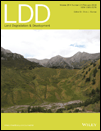Ver ítem
- xmlui.general.dspace_homeCentros e Institutos de InvestigaciónCIRN. Centro de Investigaciones de Recursos NaturalesInstituto de SuelosArtículos científicosxmlui.ArtifactBrowser.ItemViewer.trail
- Inicio
- Centros e Institutos de Investigación
- CIRN. Centro de Investigaciones de Recursos Naturales
- Instituto de Suelos
- Artículos científicos
- Ver ítem
Aridity and overgrazing have convergent effects on ecosystem structure and functioning in Patagonian rangelands
Resumen
Over 65% of drylands are used for grazing of managed livestock. Understanding what drives grazing effects on the structure and functioning of rangelands is critical for achieving their sustainability. We studied a network of 239 sites across Patagonian rangelands (Argentina), which constitute one of the world's largest rangeland area. We aimed to (i) evaluate how aridity and grazing affect ecosystem structure and functioning and (ii) test the usefulness
[ver mas...]
Over 65% of drylands are used for grazing of managed livestock. Understanding what drives grazing effects on the structure and functioning of rangelands is critical for achieving their sustainability. We studied a network of 239 sites across Patagonian rangelands (Argentina), which constitute one of the world's largest rangeland area. We aimed to (i) evaluate how aridity and grazing affect ecosystem structure and functioning and (ii) test the usefulness of the landscape function analysis (LFA) indices (stability, infiltration and nutrient cycling) as surrogates of soil functioning. Aridity decreased species richness and the cover of palatable grasses but increased the cover of palatable shrubs. Grazing pressure negatively impacted the cover of palatable grasses and species richness but did not affect the cover of shrubs. Aridity had direct and indirect negative relationships with the LFA indices. Grazing pressure had no direct effects on the LFA indices but had an indirect negative effect on them by affecting vegetation structure. The LFA indices were positively and negatively correlated with soil organic carbon and sand contents, respectively, suggesting that these indices are useful proxies of soil functional processes in Patagonian rangelands. Our findings indicate that aridity and overgrazing have convergent effects on the structure and functioning of ecosystems, as both promoted reductions in species richness, the cover of palatable grasses and soil functioning. Rangeland management activities should aim to enhance species richness and the cover of palatable grasses, as these actions could contribute to offset adverse effects of ongoing increases in aridity on drylands
[Cerrar]

Autor
Gaitan, Juan Jose;
Bran, Donaldo Eduardo;
Oliva, Gabriel Esteban;
Aguiar, Martín Roberto;
Buono, Gustavo Gabriel;
Ferrante, Daniela;
Nakamatsu, Viviana Beatriz;
Ciari, Georgina;
Salomone, Jorge Manuel;
Massara Paletto, Virginia;
Garcia Martinez, Guillermo Carlos;
Maestre, Fernando Tomás;
Fuente
Land degradation & development 29 (2) : 210–218. (February 2018)
Fecha
2018-02
ISSN
1085-3278
1099-145X
1099-145X
Formato
pdf
Tipo de documento
artículo
Palabras Claves
Derechos de acceso
Restringido
 Excepto donde se diga explicitamente, este item se publica bajo la siguiente descripción: Creative Commons Attribution-NonCommercial-ShareAlike 2.5 Unported (CC BY-NC-SA 2.5)
Excepto donde se diga explicitamente, este item se publica bajo la siguiente descripción: Creative Commons Attribution-NonCommercial-ShareAlike 2.5 Unported (CC BY-NC-SA 2.5)

